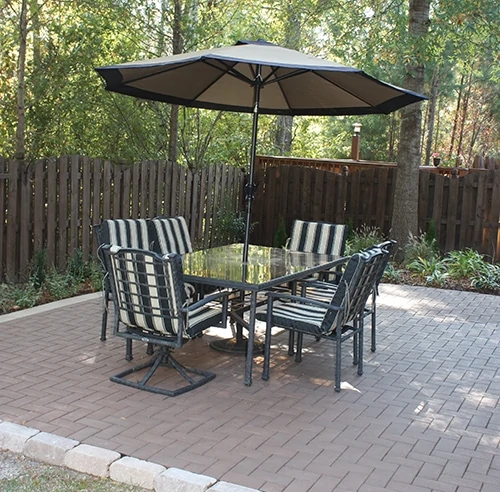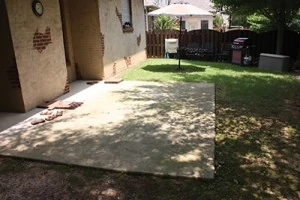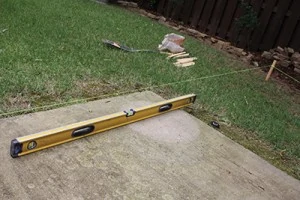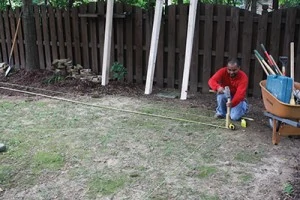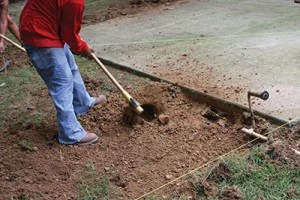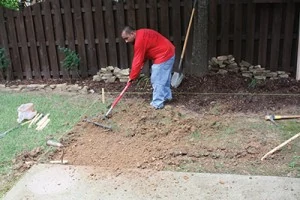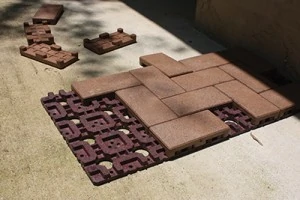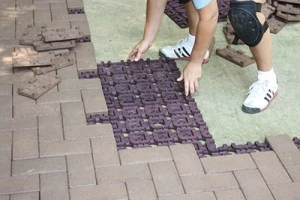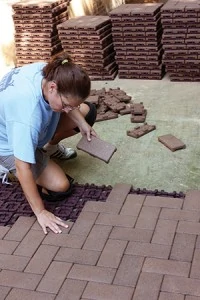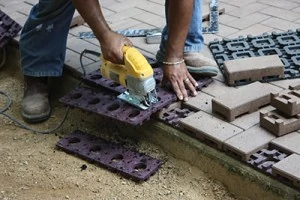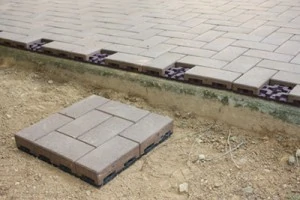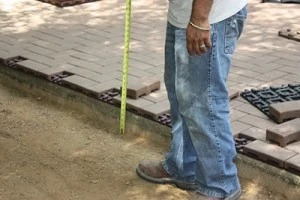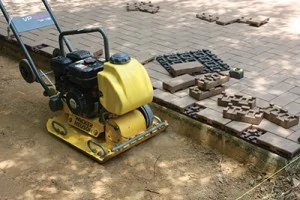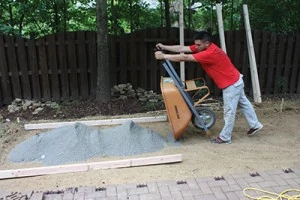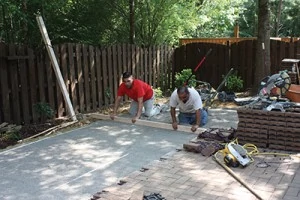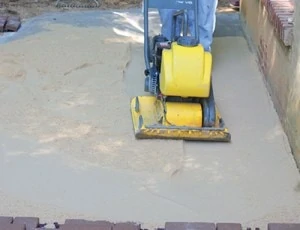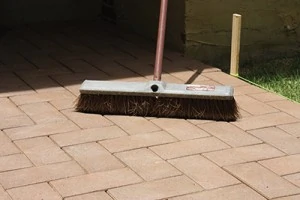Build a patio with composite pavers in an interlocking grid system.
Julie Quigley wanted a large backyard patio with the look of traditional pavers. Her house had a small concrete patio, and the plan was to cover it in pavers and extend the new surface for a larger overall patio area.
The job site had its challenges, however. The yard was confined within a wooden fence in close proximity to the surrounding neighbors. The only access was through a narrow walk-through gate, so the patio area couldn’t be accessed by truck to deliver the materials.
The solution to these problems was found in the unique features of Azek composite pavers. Azek pavers are made from up to a 95-percent composite blend of post-consumer recycled automobile tires and plastic containers. The material is one-third the weight of concrete, meaning they’re much easier to move by wheelbarrow than standard pavers when you can’t use a truck. For Quigley’s circumstance, this saved a lot of labor and time in transportation and site prep.
The pavers also come in different thicknesses The Resurface pavers are a thinner profile to cover old patios such as the existing slab. And the Standard Landscape pavers are perfect for new patios and walkways, such as the planned expansion.
Furthermore, Azek pavers use a patented grid system for installation that dramatically reduces installation time and makes it easier than manually setting and aligning heavy traditional pavers. The 16-by-16-in. grid also ensures straight lines and assists with a level layout. Plus, the pavers can be cut using a regular miter or jigsaw—no wet saw required.
Step-by-step
Make sure the patio site is not located where standing, above-ground water conditions are anticipated. For this project an underground downspout extension was installed to divert water away from the expansion area.
Proper sub-base grading and other storm-water management designs should prevent the appearance of water at grade-level. Contractor Anthony Muñoz made sure the patio maintained the slope of the existing patio to drain water away from the house.
The patio site was laid out and squared up with stakes and string. This provides a visible guideline for the installation to follow.
To prepare for the flexible-base expansion, the installers had to break ground and level the earth. Prior to excavating the site, ensure all underground utilities (e.g. electrical lines, phone lines, water lines) have been properly located and identified. This project required relocating an underground sprinkler.
The ground had to be graded evenly in preparation for the crushed rock required for the flexible base.
The easiest part of this patio project was resurfacing the existing slab. The Azek pavers install over a grid system, with pavers installed over two adjoining grids to interlock the foundation.
The grid lays directly over the existing slab, and the interlocking system is held in place by weight and friction. The slab was in good, flat condition. If the slab were damaged, it would have required self-leveling concrete or a similar product to fill in any low areas. High areas can be knocked down to create a smooth surface.
The resurfacing pavers have a thin profile to minimize the elevation of the walking surface over an existing patio. The homeowner chose a herringbone pattern for this installation.
In some cases a full-size grid may not fit into the confines of the patio site. In this case the grid can be cut with standard woodworking equipment, such as a jigsaw or circular saw with a low tooth-count ripping blade.
The Azek pavers can also be cut with woodworking tools. This is easier than using a hammer and brick set, or a wet saw, which is required for cutting standard pavers.
The resurfacing pavers were installed to the edge of the existing patio, and a decorative border would be installed later.
The sub-base of the patio extension had to be significantly built up to match evenly with the new paver surface. Azek recommends the base material should be a dense graded aggregate. Aggregate graded to 3/4-in. minus is a commonly used base material, often referred to as “class 5” or “road base.” For patios and walkways, 4 to 6 inches of compacted base is required, plus a compacted sand bed of 3/4 to 1 inch beneath the grid.
To calculate how deep to excavate, add up these layers: Excavation Depth = Base Material Thickness + Sand Bed Thickness + 2.38 inches (pavers) – 1/4 inch. (The subtraction of 1/4 inch leaves room for compaction that occurs during the final tamping.)
The contractors rented a plate compactor to tamp down the ground prior to adding the road base. This step is highly recommended to reduce settling of the soil.
Installing the road-base in sections, spreading each load as you go, can make it easier to shape the base layer.
The crushed-rock base is leveled with screed boards and then tamped down with another pass of the compactor.
The sand bed is then applied and it, too, is flattened with a third pass of the compactor.
Screeding the sand evenly creates a workable surface for the grid and pavers and makes it easier to make the installation even.
With the sand bed flat, the grid can then be installed followed by the interlocking Standard Pavers.
Once installation is complete, the finished surface of the patio is again tamped with a compactor. This will even out small undulations and lock the pavers into place.
Finally, sweep sand into the paver joints. The same sand used for the sand bed can be used for the joint fill. This is a clean, sharp and well-graded coarse sand.
Do not use polymeric sand with the Azek pavers, because as the system expands and contracts it may cause the polymeric sands to break away from the edges of the pavers.
Azek Pavers require an edge restraint around the perimeter to help keep the installation from moving and the perimeter pavers from tipping off the grid. The edging is generally staked down using 10-in. stakes, one every 6 to 12 inches. Plastic, aluminum or concrete edging will work.
Available in five colors, Azek pavers are stain-, impact- and scratch-resistant. With an innovative grid system and less than half the weight of traditional pavers, Azek pavers install up to three times faster than other pavers. And as we discovered on this patio project, the results are a beautiful upgrade to the back-yard landscape.
Side Note
On-Site Solution
Virtually any remodeling project presents unexpected challenges, and we discovered an issue with joining the Azek Resurfacing Pavers to the grid of the Azek Standard Pavers at the the edge of the patio expansion. Pavers should cross from one grid to the adjacent grid, locking the patio system together. However, the thin profile of the Resurfacing Pavers didn’t reach the interlocking knobs of the adjoining grid. After a little deliberation, we decided to cut a shim from the thin part of a scrap resurfacing paver to make up the difference in the thickness. We then used heavy-duty construction adhesive to first glue the shim to the grid and then to the underside of of the interlocking Resurfacing Paver that joined the two grids. This workaround seemed to work well, however the photos contained herein are for display purposes only and not for the purpose of validating the suitability or safety of this particular installation or application of the product. Always consult Azek’s Installation Guide as well as local building codes to ensure proper installation.


